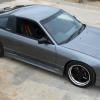Announcements
-
Similar Content
-
Latest Posts
-
Hi everyone, Recently got handed down a 2004 Skyline 350GT Coupe. I would like to change the wheels as the previous owner installed some weird ones. The current ones are 215/45ZR18, unsure of the offset, and sit pretty deep in. Would like to increase the ground clearance slightly as well as I need to get it roadworthy standard, currently sitting at 90mm. Was thinking that maybe I could kill 2 birds with 1 stone by getting new wheels. Pictures of current wheels: https://imgur.com/bg1QMIu Any recommendations for the types of wheels I should be on the lookout for? Like the maximum and minimum offset, sidewall height, width, etc. Sorry in advance if I'm noob, I do not know much about cars other than how to change the oil, a blown tyre and brakepads....
-
By joshuaho96 · Posted
Most likely your engine is toast, but also the R32 GTR has different ratios than the GTS4. In 5th it's basically the same, it's mostly 1st through 3rd that change. Stop trying to do WOT pulls before you make the engine entirely unsalvageable. Do a leakdown test and/or borescope the cylinders first. And a boost leak can overspeed a turbo. Make sure the turbo actually functions as intended. -
By Dose Pipe Sutututu · Posted
Red Bull, if you're reading this thread, please sponsor us 🥲 -
By robbo_rb180 · Posted
Just need to find some sponsor dollars and we'd be good to go.
-






Recommended Posts
Create an account or sign in to comment
You need to be a member in order to leave a comment
Create an account
Sign up for a new account in our community. It's easy!
Register a new accountSign in
Already have an account? Sign in here.
Sign In Now